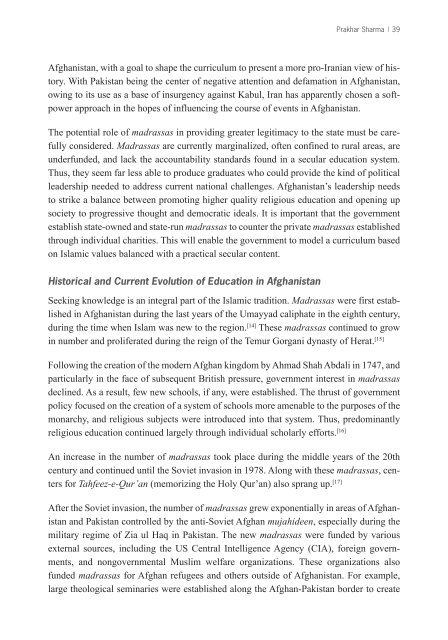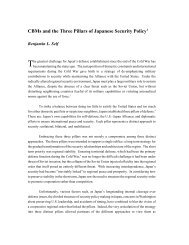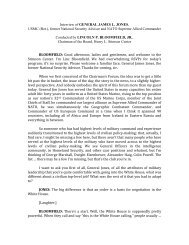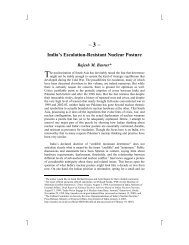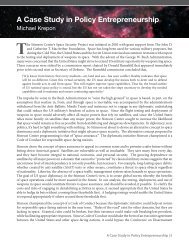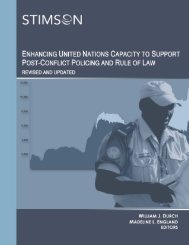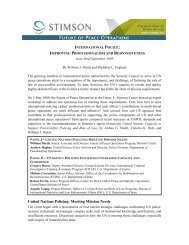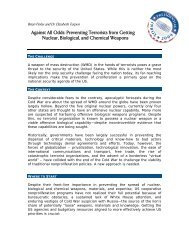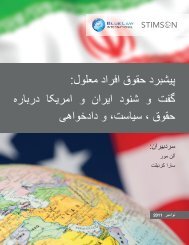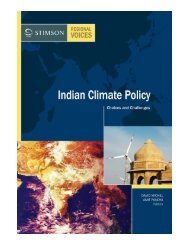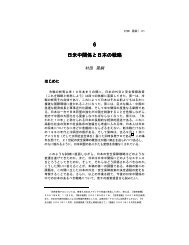Islam and Politics - The Stimson Center
Islam and Politics - The Stimson Center
Islam and Politics - The Stimson Center
Create successful ePaper yourself
Turn your PDF publications into a flip-book with our unique Google optimized e-Paper software.
Prakhar Sharma | 39<br />
Afghanistan, with a goal to shape the curriculum to present a more pro-Iranian view of history.<br />
With Pakistan being the center of negative attention <strong>and</strong> defamation in Afghanistan,<br />
owing to its use as a base of insurgency against Kabul, Iran has apparently chosen a softpower<br />
approach in the hopes of influencing the course of events in Afghanistan.<br />
<strong>The</strong> potential role of madrassas in providing greater legitimacy to the state must be carefully<br />
considered. Madrassas are currently marginalized, often confined to rural areas, are<br />
underfunded, <strong>and</strong> lack the accountability st<strong>and</strong>ards found in a secular education system.<br />
Thus, they seem far less able to produce graduates who could provide the kind of political<br />
leadership needed to address current national challenges. Afghanistan’s leadership needs<br />
to strike a balance between promoting higher quality religious education <strong>and</strong> opening up<br />
society to progressive thought <strong>and</strong> democratic ideals. It is important that the government<br />
establish state-owned <strong>and</strong> state-run madrassas to counter the private madrassas established<br />
through individual charities. This will enable the government to model a curriculum based<br />
on <strong>Islam</strong>ic values balanced with a practical secular content.<br />
Historical <strong>and</strong> Current Evolution of Education in Afghanistan<br />
Seeking knowledge is an integral part of the <strong>Islam</strong>ic tradition. Madrassas were first established<br />
in Afghanistan during the last years of the Umayyad caliphate in the eighth century,<br />
during the time when <strong>Islam</strong> was new to the region. [14] <strong>The</strong>se madrassas continued to grow<br />
in number <strong>and</strong> proliferated during the reign of the Temur Gorgani dynasty of Herat. [15]<br />
Following the creation of the modern Afghan kingdom by Ahmad Shah Abdali in 1747, <strong>and</strong><br />
particularly in the face of subsequent British pressure, government interest in madrassas<br />
declined. As a result, few new schools, if any, were established. <strong>The</strong> thrust of government<br />
policy focused on the creation of a system of schools more amenable to the purposes of the<br />
monarchy, <strong>and</strong> religious subjects were introduced into that system. Thus, predominantly<br />
religious education continued largely through individual scholarly efforts. [16]<br />
An increase in the number of madrassas took place during the middle years of the 20th<br />
century <strong>and</strong> continued until the Soviet invasion in 1978. Along with these madrassas, centers<br />
for Tahfeez-e-Qur’an (memorizing the Holy Qur’an) also sprang up. [17]<br />
After the Soviet invasion, the number of madrassas grew exponentially in areas of Afghanistan<br />
<strong>and</strong> Pakistan controlled by the anti-Soviet Afghan mujahideen, especially during the<br />
military regime of Zia ul Haq in Pakistan. <strong>The</strong> new madrassas were funded by various<br />
external sources, including the US Central Intelligence Agency (CIA), foreign governments,<br />
<strong>and</strong> nongovernmental Muslim welfare organizations. <strong>The</strong>se organizations also<br />
funded madrassas for Afghan refugees <strong>and</strong> others outside of Afghanistan. For example,<br />
large theological seminaries were established along the Afghan-Pakistan border to create


